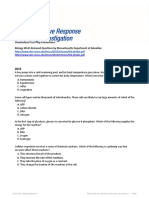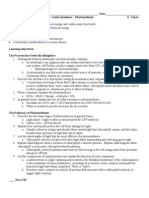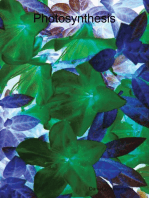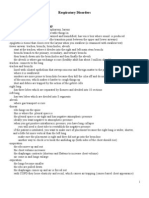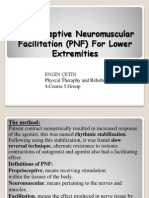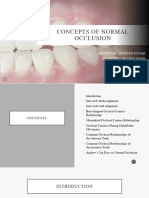0 ratings0% found this document useful (0 votes)
21 viewsCyto C
Cyto C
Uploaded by
MohibCytochrome c is a small heme protein found in the inner mitochondrial membrane that plays a key role in electron transport as it carries electrons from Complex III to Complex IV. It has a highly conserved amino acid sequence among mammals and consists of around 100 amino acids. Cytochrome c accepts electrons from Coenzyme Q-cytochrome c reductase and donates them to cytochrome oxidase as part of oxidative phosphorylation. It is also involved in apoptosis when released from the mitochondria.
Copyright:
© All Rights Reserved
Available Formats
Download as PPTX, PDF, TXT or read online from Scribd
Cyto C
Cyto C
Uploaded by
Mohib0 ratings0% found this document useful (0 votes)
21 views10 pagesCytochrome c is a small heme protein found in the inner mitochondrial membrane that plays a key role in electron transport as it carries electrons from Complex III to Complex IV. It has a highly conserved amino acid sequence among mammals and consists of around 100 amino acids. Cytochrome c accepts electrons from Coenzyme Q-cytochrome c reductase and donates them to cytochrome oxidase as part of oxidative phosphorylation. It is also involved in apoptosis when released from the mitochondria.
Original Title
cyto c
Copyright
© © All Rights Reserved
Available Formats
PPTX, PDF, TXT or read online from Scribd
Share this document
Did you find this document useful?
Is this content inappropriate?
Cytochrome c is a small heme protein found in the inner mitochondrial membrane that plays a key role in electron transport as it carries electrons from Complex III to Complex IV. It has a highly conserved amino acid sequence among mammals and consists of around 100 amino acids. Cytochrome c accepts electrons from Coenzyme Q-cytochrome c reductase and donates them to cytochrome oxidase as part of oxidative phosphorylation. It is also involved in apoptosis when released from the mitochondria.
Copyright:
© All Rights Reserved
Available Formats
Download as PPTX, PDF, TXT or read online from Scribd
Download as pptx, pdf, or txt
0 ratings0% found this document useful (0 votes)
21 views10 pagesCyto C
Cyto C
Uploaded by
MohibCytochrome c is a small heme protein found in the inner mitochondrial membrane that plays a key role in electron transport as it carries electrons from Complex III to Complex IV. It has a highly conserved amino acid sequence among mammals and consists of around 100 amino acids. Cytochrome c accepts electrons from Coenzyme Q-cytochrome c reductase and donates them to cytochrome oxidase as part of oxidative phosphorylation. It is also involved in apoptosis when released from the mitochondria.
Copyright:
© All Rights Reserved
Available Formats
Download as PPTX, PDF, TXT or read online from Scribd
Download as pptx, pdf, or txt
You are on page 1of 10
The Cytochrome complex, or cyt c is a small
heme protein found loosely associated with the
inner membrane of the mitochondrion.
It belongs to the cytochrome c family of
proteins.
highly soluble protein, with a solubility of
about 100 g/L and is an essential component of
the electron transport chain.
it carries one electron, capable of undergoing
oxidation and reduction, but does not bind
oxygen.
found in plants, animals, and many unicellular
organisms.
small size (mol.wt.about 12,000 daltons).
Its primary structure consists of a chain of
about 100 amino acids. Many higher order
organisms possess a chain of 104 amino acids.
Its amino acid sequence is highly conserved in
mammals differing by only a few residues. For
example, the sequences of cytochrome c in
humans is identical to that of a chimpanzees but
differs more from that of a horses, and even
more from the sequence of a shark.
Cytochrome c accepts electrons from Complex
III and diffuses to Complex IV (cytochrome
oxidase), where it donates the electrons to O2,
converting O2 to H2O.
In humans, cytochrome c is encoded by the
CYCS gene.
FUNCTIONS:
Cytochrome c is a component of the
electron transport chain in mitochondria.
The heme group of cytochrome c accepts
electrons from the b-c1 complex (Coenzyme Q -
Cyt C reductase) to the cytochrome oxidase
complex.
Upon release of cytochrome c to the
cytoplasm, the protein binds apoptotic protease
activating factor-1 (Apaf-1).
Cytochrome c can catalyze several reactions
such as hydroxylation and aromatic oxidation.
In the process of oxidative phosphorylation,
Cyt c play important role.
Classes:
In 1991 R. P. Ambler recognized four classes of
cyt c:
Class I includes the low spin soluble
cytochrome c of mitochondria and bacteria. It
has the heme-attachment site towards the N
terminus of histidine and the sixth ligand
provided by a methionine residue towards the C
terminus.
Class II includes the high spin cytochrome c'.
It has the heme-attachment site closed to the N
terminus of histidine.
Class III comprises the low redox potential
multiple heme cytochromes. The heme c groups
are structurally and functionally nonequivalent
and present different redox potentials in the
range 0 to -400 mV.
Class IV was originally created to hold the
complex proteins that have other prosthetic
groups as well as heme c.
Applications
Cytochrome c is suspected to be the functional
complex in so called LLLT:
Low-level laser therapy.
In LLLT, red light and some near infra-red
wavelengths penetrate tissue in order to increase
cellular regeneration.
Light of this wavelength appears capable of
increasing activity of cytochrome c, thus
increasing metabolic activity and freeing up
more energy for the cells to repair the tissue.
You might also like
- Afifi AK, Functional Neuroanatomy. 2005 (Book)Document873 pagesAfifi AK, Functional Neuroanatomy. 2005 (Book)Eguzki Izukaitz Noguera100% (1)
- Panchabhautik Chikitsa PDFDocument229 pagesPanchabhautik Chikitsa PDFBhavana Gangurde82% (11)
- Acute Renal Failure Comprehensive Case AnalysisDocument7 pagesAcute Renal Failure Comprehensive Case Analysisate NarsNo ratings yet
- Introduction To BiochemistryDocument32 pagesIntroduction To BiochemistryHazel LouNo ratings yet
- Cell Biology Mitochondria - 1-8-2Document8 pagesCell Biology Mitochondria - 1-8-2Aishwarya PujarNo ratings yet
- TBR Bio2 OptDocument495 pagesTBR Bio2 Optmeyangli88% (26)
- Cytochrome CDocument2 pagesCytochrome CJohn OsborneNo ratings yet
- Know More: WeblinksDocument5 pagesKnow More: WeblinkskottooranjohnbNo ratings yet
- BiomoleculesDocument7 pagesBiomoleculesBhagath J PrakashNo ratings yet
- Topic g BIOL 110 Energy and RespirationDocument23 pagesTopic g BIOL 110 Energy and RespirationitzbelyseNo ratings yet
- Selangor AnsDocument4 pagesSelangor AnsChan Yu QianNo ratings yet
- Bioinorganic Chemistry 1Document44 pagesBioinorganic Chemistry 1Abu S. M. GulamaNo ratings yet
- Biomolecules ??Document7 pagesBiomolecules ??resmaahreshNo ratings yet
- Bioenergetics 20240416 114937 0000Document72 pagesBioenergetics 20240416 114937 0000Alexandra jade PagatpatanNo ratings yet
- Lectuer # 9Document23 pagesLectuer # 9muhammadhatibhasan6No ratings yet
- Cell Bio PracticeDocument11 pagesCell Bio PracticeNgMinhHaiNo ratings yet
- Fatty Acid MetabolismDocument8 pagesFatty Acid MetabolismJessicaOktavianusNo ratings yet
- In Relation To Lsm2101 Lec 2Document11 pagesIn Relation To Lsm2101 Lec 2jojolim18No ratings yet
- Mitochondria FinalDocument44 pagesMitochondria Finaltamilavatar06No ratings yet
- Module 4 RevisedDocument29 pagesModule 4 Revisedrosel indolosNo ratings yet
- Genbio1 Quarter2 M4Document17 pagesGenbio1 Quarter2 M4Janine DanzalanNo ratings yet
- TBC InggrisDocument22 pagesTBC InggrisNurlindaNo ratings yet
- Lec 8Document11 pagesLec 8s5022088No ratings yet
- Electron TransportDocument8 pagesElectron Transportเทพนิมิตร สมภักดีNo ratings yet
- Pertemuan 11 (Respirasi, Glikolisis, Siklus Krebs)Document25 pagesPertemuan 11 (Respirasi, Glikolisis, Siklus Krebs)Lilis TuslinahNo ratings yet
- Cellular RespirationDocument33 pagesCellular RespirationacostaxyrhelleNo ratings yet
- Chapter 5Document26 pagesChapter 5Al Ahad ShajibNo ratings yet
- Lecture Cellular Respiration XiaoxuDocument24 pagesLecture Cellular Respiration Xiaoxuapi-366307926No ratings yet
- Standardized Test Prep Teacher Sheets Mammalian Dive Response Laboratory InvestigationDocument5 pagesStandardized Test Prep Teacher Sheets Mammalian Dive Response Laboratory InvestigationMaria TorresNo ratings yet
- Biology Form 5Document5 pagesBiology Form 5syiqinnNo ratings yet
- FATTY ACID OXIDATION (Beta-Oxidation) ...Document9 pagesFATTY ACID OXIDATION (Beta-Oxidation) ...atifzeaNo ratings yet
- BIOENERGETICS - How The Body Converts Food To Energy - Group 7 (MC 102 - Lecture) EDITEDDocument73 pagesBIOENERGETICS - How The Body Converts Food To Energy - Group 7 (MC 102 - Lecture) EDITEDJowe Varnal100% (1)
- APBioCh10ReadingGuide10 11Document2 pagesAPBioCh10ReadingGuide10 11Sergio LivingroomsNo ratings yet
- Chapter 13-The Respiratory Chain and Oxidative PhosphorylationDocument12 pagesChapter 13-The Respiratory Chain and Oxidative Phosphorylationjdcruz7199No ratings yet
- 10th Science PLANT PHYSIOLOGY AND PLANT ANATOMY NotesDocument4 pages10th Science PLANT PHYSIOLOGY AND PLANT ANATOMY Notesarunachalam862005No ratings yet
- Cellular Respiration: Index To This PageDocument6 pagesCellular Respiration: Index To This PageVictor VegaNo ratings yet
- The Mitochondria 1Document60 pagesThe Mitochondria 1www.shamiff.w32No ratings yet
- ChloroplastDocument20 pagesChloroplastHarry HartNo ratings yet
- Electron Transport ChainDocument3 pagesElectron Transport ChainGladys Mae JuanNo ratings yet
- Etc PDFDocument14 pagesEtc PDFjamalNo ratings yet
- Bioenergetics (1)Document20 pagesBioenergetics (1)rajridoy35No ratings yet
- Ange EeeeeDocument4 pagesAnge EeeeeHazel BandayNo ratings yet
- Cellular Respiration PDFDocument15 pagesCellular Respiration PDFJovicaNo ratings yet
- GENERAL BIOLOGY Q2 WEEK 6 Glycolysis and Kreb CycleDocument14 pagesGENERAL BIOLOGY Q2 WEEK 6 Glycolysis and Kreb CycleAryan Jovic DomingoNo ratings yet
- Biological Oxidation by SatishDocument12 pagesBiological Oxidation by SatishBiochemistry DenNo ratings yet
- Regulation of Oxidative PhosphorylationDocument14 pagesRegulation of Oxidative Phosphorylationmaaz629No ratings yet
- BCH-102-Principles of BiochemistryDocument98 pagesBCH-102-Principles of Biochemistrydeepali sachaNo ratings yet
- BC II - UNIT 3 EditedDocument106 pagesBC II - UNIT 3 Editedapoorva140604No ratings yet
- Etc (Electron Transport Chain)Document24 pagesEtc (Electron Transport Chain)Dark_KiroNo ratings yet
- Question Bank STD Xi BiologyDocument8 pagesQuestion Bank STD Xi BiologyUsmaan SheikhNo ratings yet
- Botany Paper Solved 2024 UpdatedDocument25 pagesBotany Paper Solved 2024 Updatedanwernawaz234No ratings yet
- BiochimieDocument11 pagesBiochimieecosysNo ratings yet
- Essay Questions BiologyDocument4 pagesEssay Questions Biologyselina_kollsNo ratings yet
- Q1 Week 8 Biology G9Document14 pagesQ1 Week 8 Biology G9Alvin DuaneNo ratings yet
- Presentasi Sumber Daya Alam Kolase Hijau Tua CokelatDocument12 pagesPresentasi Sumber Daya Alam Kolase Hijau Tua Cokelateniekawati58No ratings yet
- Bottom Up Regulation of Plant RespirationDocument13 pagesBottom Up Regulation of Plant RespirationPradeep NagarajNo ratings yet
- BiomoleculesDocument7 pagesBiomoleculesvjaNo ratings yet
- Chapter 9 Study Guide - VMDocument4 pagesChapter 9 Study Guide - VMVM27340% (1)
- BT101 MidsemDocument3 pagesBT101 MidsemthedogbirdsNo ratings yet
- Chapetr 2 Animal CellDocument12 pagesChapetr 2 Animal CellhabetamuurmaleNo ratings yet
- CHLOROPLASTDocument4 pagesCHLOROPLASTjyotirmoy choudhuryNo ratings yet
- A-level Sciences Revision Boxset: Cheeky Revision ShortcutsFrom EverandA-level Sciences Revision Boxset: Cheeky Revision ShortcutsRating: 3 out of 5 stars3/5 (2)
- Plant Physiology and Ecology-31Document18 pagesPlant Physiology and Ecology-31MohibNo ratings yet
- Excel Keyboard Shortcuts (1) by GuriDocument2 pagesExcel Keyboard Shortcuts (1) by GuriMohibNo ratings yet
- Enzyme KineticsDocument13 pagesEnzyme KineticsMohib100% (1)
- Plant Physiology and Ecology-30Document26 pagesPlant Physiology and Ecology-30MohibNo ratings yet
- BA BSC Computer Science Guess Papers 2022 Part-2 by Admins Urdu BooksDocument1 pageBA BSC Computer Science Guess Papers 2022 Part-2 by Admins Urdu BooksMohibNo ratings yet
- Computer Shortcuts-001Document2 pagesComputer Shortcuts-001MohibNo ratings yet
- History of Pakistan India 2018Document2 pagesHistory of Pakistan India 2018MohibNo ratings yet
- Districts of Pakistan - Wikipedia by GuriDocument18 pagesDistricts of Pakistan - Wikipedia by GuriMohibNo ratings yet
- Excel If FunctionDocument3 pagesExcel If FunctionMohibNo ratings yet
- Advances in Plant Taxonomy by SekhloDocument5 pagesAdvances in Plant Taxonomy by SekhloMohibNo ratings yet
- Access Keyboard ShortcutsDocument2 pagesAccess Keyboard ShortcutsMohibNo ratings yet
- AJK Board of Intermediate & Secondary Education Mirpur AJKDocument1 pageAJK Board of Intermediate & Secondary Education Mirpur AJKMohibNo ratings yet
- AJK Board of Intermediate & Secondary Education Mirpur AJKDocument1 pageAJK Board of Intermediate & Secondary Education Mirpur AJKMohibNo ratings yet
- Bacteriology and Virology by KaziDocument35 pagesBacteriology and Virology by KaziMohibNo ratings yet
- Ecology 3rd SemesterDocument38 pagesEcology 3rd SemesterMohibNo ratings yet
- Overview of Digestive System 16-01-23Document20 pagesOverview of Digestive System 16-01-23erisericssonNo ratings yet
- Biorad InsertDocument1 pageBiorad InsertJohnmar AquinoNo ratings yet
- HistologyDocument4 pagesHistologyTAHIR KHAN ATHMANNo ratings yet
- ATP Production Through Lipid CatabolismDocument1 pageATP Production Through Lipid CatabolismZaivie VillanobosNo ratings yet
- Respiratory DisordersDocument17 pagesRespiratory DisordersBrandi Worley100% (2)
- Science Fair Research PlanDocument9 pagesScience Fair Research Planapi-200833316No ratings yet
- Neonatal Golden HourDocument28 pagesNeonatal Golden HourGendis Ayu ArdiasNo ratings yet
- Dockong WebsiteDocument13 pagesDockong WebsitesripteraptorNo ratings yet
- Mechanism of FloweringDocument40 pagesMechanism of FloweringIrdatul WardahNo ratings yet
- Peritoneal Cavity Anatomy in CT PeritoneographyDocument24 pagesPeritoneal Cavity Anatomy in CT PeritoneographyHugo Alberto C FNo ratings yet
- ShockDocument30 pagesShockvinnu kalyanNo ratings yet
- Dental Pulse 12th Ed - PhysiologyDocument107 pagesDental Pulse 12th Ed - PhysiologyLangNo ratings yet
- Tesis Huelbes AlonsoDocument349 pagesTesis Huelbes AlonsoEmmanuel BrizuelaNo ratings yet
- Photosynthesis and RespirationDocument3 pagesPhotosynthesis and RespirationjalahdixonNo ratings yet
- PNF For Lower LimbDocument22 pagesPNF For Lower LimbsanalcrazyNo ratings yet
- TN - Increase in Seats Based On LOP and Expected Total Seats in TNDocument3 pagesTN - Increase in Seats Based On LOP and Expected Total Seats in TNAshok PaskalrajNo ratings yet
- Family Case AnalysisDocument141 pagesFamily Case AnalysisCarl Elexer Cuyugan Ano79% (14)
- Concepts of Normal OcclusionDocument73 pagesConcepts of Normal OcclusionAditi Singh100% (1)
- MagalhaesDocument3 pagesMagalhaesDaniel LoebmannNo ratings yet
- SSES - Science3 Module 2 Week 2Document15 pagesSSES - Science3 Module 2 Week 2Ryza Nicole OjedaNo ratings yet
- Anemia in PregnancyDocument12 pagesAnemia in PregnancyWulan AbadiNo ratings yet
- Zoology Skelton PaperDocument13 pagesZoology Skelton PaperBhavna SharmaNo ratings yet
- Free Workout Program PDFDocument6 pagesFree Workout Program PDFAndyNo ratings yet
- Usmle Board Review Step 1Document357 pagesUsmle Board Review Step 1pereje7067% (3)
- Defense Mechanism (IB)Document60 pagesDefense Mechanism (IB)wirdahajaNo ratings yet
- Sample Nurse's NotesDocument1 pageSample Nurse's Notesever existenceNo ratings yet




























